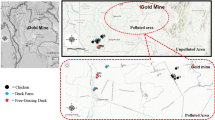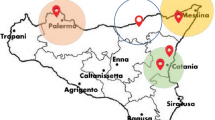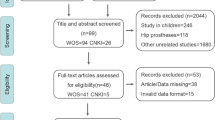Abstract
There is global concern about heavy metal contamination in the environment. Adverse health effects can be caused by heavy metals in contaminated food and water. Therefore, environmental monitoring studies and risk assessments should be conducted periodically. In this study, we measured levels of Cd, Cr, Cu, Hg, Mn, Ni, Pb, and Zn in blood cockles (Anadara granosa) collected from three locations in the Upper Gulf of Thailand. Hazard quotients and hazard indices were calculated to evaluate the health risks posed by heavy metals in consumed blood cockles. Heavy metal concentrations in all of the blood cockle samples were lower than the relevant food standards. The hazard quotients and hazard indices were <1 in all three sampling areas, indicating that adverse health effects were not likely to be caused by exposure to heavy metals in blood cockles over a human lifetime.



Similar content being viewed by others
References
Abouhend, El-Moselhy (2015) Spatial and seasonal variations of heavy metals in water and sediments at the Northern Red Sea Coast. American Journal of Water Resources 3(3):73–85
Aoonhalekka J, Limsatjasakul J, Jankeaw N, Watsawang S, Torprasit S, Wanichacheewa P, Rojjanapanthip L (2011) Study of lead, cadmium, tin and mercury contamination in blood cockle and green mussel in the inner gulf of Thailand. FDA J 1:15–22 (in Thai)
ATSDR (1999) Toxicological profile for mercury. U.S. Department of Health and Human Services. http://www.atsdr.cdc.gov/toxprofiles/tp46.pdf. Accessed: 6 Sept 2015
ATSDR (2004) Toxicological profile for copper. U.S. Department of Health and Human Services. http://www.atsdr.cdc.gov/ToxProfiles/tp132.pdf. Accessed: 17 July 2016
ATSDR (2005a) Toxicology profile for Nickel. U.S. Department of Health and Human Services. http://www.atsdr. cdc.gov/toxprofiles/tp15.pdf. Accessed 6 Sept 2015
ATSDR (2005b) Toxicological profile for Zinc. U.S. Department of Health and Human Services. http://www.atsdr. cdc.gov/toxprofiles/tp60.pdf. Accessed 6 Sept 2015
ATSDR (2007) Toxicology profile for lead. U.S. Department of Health and Human Services. http://www.atsdr.cdc.gov/toxprofiles/tp13.pdf. Accessed 17 July 2016
ATSDR (2012) Toxicology profile for Manganese. U.S. Department of Health and Human Services. http://www.atsdr.cdc.gov/toxprofiles/tp151.pdf. Accessed 6 Sept 2015
Auiyawong B (2008) Heavy metal concentrations in green-lipped mussels and blood cockles collected from wild and aquaculture sites in Ban Laem District, Phetchaburi Province. Research report submitted to National Research Council, Thailand. 47 pages (in Thai)
Australian Government Federal Register of Legislation (2008) Australia New Zealand Food Standard: Contaminates and Natural Toxicants. Australian Government Federal Register of Legislation. https://www.legislation.gov.au/Details/F2013C00140. Accessed 15 Jan 2016
Bardach JE, Ryther JH, McLarney WO (1974) Aquaculture: the farming husbandry of freshwater and marine organisms. Wiley, New York
Broom MJ (1985) ICLRM Studies and review 12—the biology and culture of marine bivalve molluscs of the genus Anadara. International Center for Living Aquatic Resources Management, Manila
Budin K, Sakari M, Praveena SM, Ismail N, Jalimin A (2013) Concentrations of Cd, Pb, Cu, and Zn in gastropods available in major markets of Kota Kinabalu, Sabah. In: Proceedings of the 2nd international conference on environment, agriculture and food science (ICEAFS 2013) August 25–26, 2013, Kuala Lumpur, Malaysia
Cheevaporn V, Menasveta P (2003) Water pollution and habitat degradation in the Gulf of Thailand. Mar Pollut Bull 47:43–51
Department of Industrial Work (2015) Industry Data. http://www.diw.go.th/hawk/content.php?mode=data1search. Accessed 27 Sept 2015
Department of Mineral Resources (2012) Physical geology of the Upper Gulf of Thailand. Academic Report No. BGT 9/2012. Bureau of Geotechnology, Department of Mineral Resources. 89 pages (in Thai)
Dinis MDL, Fiúza A (2011) Exposure assessment to heavy metals in the environment: measures to eliminate or reduce the exposure to critical receptors. In: Simeonov LI, Kochubovski MV, Simeonova BG (eds) Environmental heavy metal pollution and effects on child mental development—risk assessment and prevention strategies. Springer, Dordrecht, pp 27–50
European Union (2002) Commission regulation (EC) no 221/2002 of 6 February 2002 amending regulation (EC) no 466/2001 setting maximum levels for certain contaminants in foodstuffs. Official Journal of the European Union. European Union, Brussels
European Union (2014) Commission regulation no 488/2014 of 12 May 2014 amending regulation (EC) no 1881/2006 as regards maximum levels of cadmium in foodstuffs. Official Journal of the European Union. European Union, Brussels
Evanko CR, Dzombak DA (1997) Technology evaluation report TE-97-01—remediation of metals-contaminated soils and groundwater. GWRTAC, Pittsburgh
FAO (1995) Codex general standard for contaminants and toxins in food and feed (CODEX STAN 193–1995). http://www.fao.org/fileadmin/user_upload/livestockgov/documents/1_CXS_193e.pdf. Accessed 17 July 2016
FAO (2016) Species fact sheets - Anadara granosa (Linnaeus, 1758). http://www.fao.org/fishery/species/3503/en. Accessed 17 July 2016
Fumikazu Y, Hata A, Tonegawa H (1999) Itai-itai disease and the countermeasures against cadmium pollution by the Kamioka mine. Environ Econ Pol Stud 2:215–229
Giandomenico S, Cardellicchio N, Spada L, Annicchiarco C, Di Leo A (2016) Metals and PCB levels in some edible marine organisms from the lonian Sea: dietary intake evaluation and risk for consumers. Environ Sci Pollut Res 23:12596–12612. doi:10.1007/s11356-015-5280-2
Guzmán HM, García EM (2002) Mercury levels in coral reefs along the Caribbean coast of Central America. Mar Pollut Bull 44:1415–1420
Harada M (1995) Minamata disease: methylmercury poisoning in Japan caused by environmental pollution. Crit Rev Toxicol 25:1–24
Hasegawa H, Mofizur Rahman IMD, Rahman MA (2016) Environmental remediation technologies for metal-contaminated soils. Springer, Tokyo
Hemmakorn K (2002) Cadmium and lead in green mussel of different ages collected from both raft and pole culture methods at Sriracha Fisheries Research Station Area, Chon Buri province, Master’s thesis of Science (Environmental Science), College of Environment, Kasetsart University
Hungspreugs M, Yuangthong C (1984) The present levels of heavy metals in some molluscs of the upper gulf of Thailand. Water Air Soil Pollut 22:395–402
Ibrahim N (1995) Trace element content of Malaysian cockles (Anadara granosa). Food Chem 54:133–135
Ishak RA, Mohamad S, Soo KT, Hamid SF (2016) Leachate and surface water charecterization and heavy metal health risk on cockles in Kuala Selangor. Procedia-Social and Behavioral Science 222:263–271
Järup L (2003) Hazards of heavy metal contamination. Br Med Bull 68:167–182
Jović M, Stanković S (2014) Human exposure to trace metals and possible public health risks via consumption of mussels Mytilus galloprovincialis from the Adriatic coastal area. Food Chem Toxicol 70:241–251. doi:10.1016/j.fct.2014.05.012
Kacar A, Pazi I, Gonul T, Kucuksezgin F (2016) Marine pollution risk in a coastal city: use of an eco-genotoxic tool as a stress indicator in mussels from the Eastern Aegean Sea. Environ Sci Pollut Res (in press). doi:10.1007/s11356-016-6783-1
Khowhit S, Chunkao K, Inkapatanakul W, Phewnil O, Boutson A (2013) The study of heavy metal concentrations (As, Cd, Cr, Hg, Ni and Pb) in the tissue of edible bivalves mollusks living within coastal area receiving effluent from Phetchaburi municipality wastewater treatment system, Laem Phak Bia sub district, Ban Laem district, Phetchaburi Province. Thai Toxicol J 28:17–26
Koh SM, Koh PK, Sim KT, Lee YK, Salmiah S (2008) Proximate analysis and heavy metal concentrations of tissue of cockles (Anadara granosa) from several farms in Peninsular Malaysia. Sains Malaysiana 40(2):139–146
Land Development Department (2011) Land Use Development Map, Phetchaburi Province. http://www.ldd.go.th. Accessed 27 Sept 2015
Liu F, Ge J, Hu X, Fei T, Li Y, Jiang Y, Xu Z, Ding S, Giesy JP, Pan J (2009) Risk to humans of consuming metals in anchovy (Coilia sp.) from the Yangtze River Delta. Environ Geochem Health 31:727–740
Mat I, Maah AJ (1994) An assessment of trace metals pollution in the mud flats of Kuala Selengor and Batu Kawan, Malaysia. Marine Pollution Bullentin 28(8):512–514
Md Yunus S, Hamzah Z, Ariffin NAN, Muslim MB (2014) Cadmium, chromium, copper, lead, ferum and zinc levels in the cockles (Anadara granosa) from Kuala Selangor, Malaysia. MJAS 18(3):514–521
Mensah E, Kyei-Baffour N, Ofori E, Obeng G (2007) Influence of human activities and land use on heavy metal concentrations in irrigated vegetables in Ghana and their health implications. In: Yanful EK (ed) Appropriate technologies for environmental protection in the developing world: selected papers from ERTEP 2007, July 17–19 2007, Ghana, Africa. Springer, Dordrecht, pp 9–14
Ministry of Public Health (1986) Notification of Ministry of Public Health, No. 98 (February 16, B.E. 2529). The Thai Royal Government Gazette BE 2529 103(23):1986
Mohammed AS, Kapri A, Goel R (2011) Heavy metal pollution: source, impact, and remedies. In: Khan MS, Zaidi A, Goel R, Musarrat J (eds) Biomanagement of metal-contaminated soils - environmental pollution volume 20. Springer, Dordrecht, pp 1–28
Muangdech A (2002) Heavy metal contents in cockles (Anadara granosa) from the mouth of the Bangpakong River. In: Proceedings of the 40th Kasetsart University annual conference: science, natural resources and environmental economics 4–7 February 2002, Kasetsart University, Bangkok, pp 312–323 (in Thai)
National Bureau of Agricultural Commodity and Food Standards (2007) Food consumption data for Thailand (ISBN 974-403-423-8). National Bureau of Agricultural Commodity and Food Standards, Bangkok
Olujimi OO, Oputu O, Fatoki O, Opatoyinbo OE, Aroyewun AO, Baruani J (2015) Heavy metals speciation and human health risk assessment at an illegal gold mining site in Igun, Osun State, Nigeria. J Health Pollut 8:19–32
Pathansali D (1966) Notes on the biology of the cockle Anadara granosa L. Proc Indo-Pac Fish Counc 11:84–98
Pawlowski L (2011) Effect of mercury and lead on the total environment. Environ Prot Eng 37:105–117
Pradit S, Shazili MAN, Towatana P, Saengmanee W (2015) Accumulation of trace metals in Anadara granosa and Anadara inaequivalvis from Pattani Bay and the Setiu Wetlands. Bull Environ Contam Toxixol. doi:10.1007/s00128-015-1717-z
Rahman SA, Wood AK, Sarmani S, Majid AA (1997) Determination of mercury and organic mercury contents in Malaysian seafood. Radioanal Nucl Chem 217(1):53–56
Riget F, Johansen P, Asmund G (1997) Uptake and release of lead and zinc by blue mussels. Experience from transplantation experiments in Greenland. Mar Poll Bull 34(10):805–815
Simanjuntak CPH, Djumanto, Rahaedjo MF, Zahid A (2012) Assessment of heavy metals (Al, Zn, Cu, Cd, Pb, and Hg) in dermasal fishes of Kuala Tanjung Coast, North Sumatra. Proceeding of the International Seminar (Industrialization of Fisheries and Marine Resources, FAPERIKA-UNRI 2012. December 2012
Stankovic S, Jovic M, Stankovic A, Katsikas L (2012) Heavy metals in seafood mussels: risks for human health. In: Lichtfouse E, Schwarzbauer J, Robert D (eds) Environmental chemistry for a sustainable world volume 1: nanotechnology and health risk. Springer, Dordrecht, pp 311–373
Tam NFY, Wong YS (1995) Spatial and temporal variations of heavy metal contamination in sediments of a mangrove swamp in. Hong Kong 31(4–12):254–261
Tchounwou PB, Yedjou CG, Patlolla AK, Sutton DJ (2012) Heavy metals toxicity and the environment. EXS 101:133–164. doi:10.1007/978-3-7643-8340-4_6
Tchounwou PB, Yedjou CG, Patlolla AK, Sutton DJ (2014) Heavy metal toxicity and the environment. In: Luch A (ed) Molecular, clinical and environmental toxicology volume 3: environmental toxicology. Springer, Basel, pp 133–164. doi:10.1007/978-3-7643-8340-4_6
Thongra-ar W, Musika C, Wongsudawan W, Munhapol A (2008) Heavy metals contamination in sediments along the eastern coast of the Gulf of Thailand. Environ Asia 1:37–45
Tu NPC, Ha NN, Agusa T, Ikemoto T, Tuyen BC, Tanabe S, Takeuchi I (2011) Trace elements in Anadara spp. (Mollusca: Bivalva) collected along the coast of Vietnam, with emphasis on regional differences and human health risk assessment. Fish Sci 77(6):1033–1043. doi:10.1007/s12562-011-0410-3
U.S. EPA (1989) Risk assessment guidance for superfund—volume I—human health evaluation manual (part a). U.S. Environmental Protection Agency, Washington, DC https://www.epa.gov/sites/production/files/2015-09/documents/rags_a.pdf. Accessed 17 July 2016
U.S. EPA (1991) Risk assessment guidance for superfund—volume I—human health evaluation manual (part B, development of risk-based preliminary remediation goals). U.S. Environmental Protection Agency, Washington, DC http://epa-prgs.ornl.gov/radionuclides/HHEMB.pdf. Accessed 17 July 2016
U.S. EPA (2004) Integrated risk information system (IRIS)—chemical assessment summary—lead and compounds (inorganic). U.S. Environmental Protection Agency, Washington, DC https://cfpub.epa.gov/ncea/iris/iris_documents/documents/subst/0277_summary.pdf. Accessed 17 July 2016
U.S. EPA (2005) Human health risk assessment protocol for hazardous waste combustion facilities. U.S. Environmental Protection Agency, Washington, DC https://epa-prgs.ornl.gov/radionuclides/2005_HHRAP.pdf. Accessed 17 July 2016
U.S. FNB (2001) Dietary reference intakes: vitamin A, vitamin K, arsenic, boron, chromium, 15 copper, iodine, iron, manganese, molybdenum, nickel, silicon, vanadium and zinc. Food and Nutrition Board, Institute of Medicine, National Academy of Sciences, National Academy Press, Washington DC Appendix C table C 14, pp. 620
Veschasit O (2008) Study on water quality and heavy metals in water, sediment and some aquatic plants in the Tha Chin River. Master’s thesis in Science (Environmental Science), College of Environment, Kasetsart University
Yap CK (2008) Comparison of heavy metal concentration (Cd, Cu, Fe, Ni and Zn) in the shells and different soft tissues of Anadara granosa collected from Jeram, Kuala Jula and Kuala Kurau, Peninsular Malaysia. Pertanika J Trop Agric Sci 31:205–215
Yolthantham T (2007) Water quality monitoring and water quality situation in Thailand (oral presentation). In: Proceedings of the 3rd WEPA international symposium on water environmental governance, Japanese Ministry of the Environment, Tokyo
Zahir MSM, Kamaruzzaman BY, John BA, Shahbudin S, Goddard JS (2011) Bioaccumulation of selected metals in the blood cockle (Anadara granosa) from Langkawi Island, Malaysia. Orient J Chem 27(3):979–984
Zhan S, Peng S, Liu C, Chang Q, Xu J (2010) Spatial and temporal variations of heavy metals in surface sediments in Bohai Bay, North China. Bull Environ Contam Toxicol 84:482–487. doi:10.1007/s00128-010-9971-6
Acknowledgements
The authors thank the Department of Social and Environmental Medicine for providing the equipment and facilities used in the study.
Author information
Authors and Affiliations
Corresponding author
Ethics declarations
Conflicts of interest
The authors declare that they have no conflicts of interest.
Additional information
Responsible editor: Philippe Garrigues
Rights and permissions
About this article
Cite this article
Sudsandee, S., Tantrakarnapa, K., Tharnpoophasiam, P. et al. Evaluating health risks posed by heavy metals to humans consuming blood cockles (Anadara granosa) from the Upper Gulf of Thailand. Environ Sci Pollut Res 24, 14605–14615 (2017). https://doi.org/10.1007/s11356-017-9014-5
Received:
Accepted:
Published:
Issue Date:
DOI: https://doi.org/10.1007/s11356-017-9014-5




